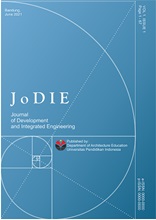DEVELOPMENT OF THE TANJUNG RINGGIT PALOPO AREA AS SPIRIT OF PLACE AREA
Abstract
This writing uses cultural and valley concepts to develop the Tanjung Ringgit Palopo area as the spirit of place area. The targets for this development are socio-cultural and economic aspects. Qualitative descriptive methods and field observations were used in this research to collect factual data about the spread of the problem. This research describes phenomena and then analyzes and presents them with systematic facts to facilitate reasoning and conclusions. Results were obtained from a social aspect by preparing a housing development program with indicators of livable houses and a healthy environment while maintaining and reconstructing traditional houses with cultural values and unique local wisdom. Meanwhile, economic development is being carried out by establishing a restaurant in Tanjung Ringgit, which can increase tourism potential in the mainstay area of Palopo. Suppose the development of these two aspects is carried out optimally by the government and local community. In that case, Tanjung Ringgit can be called the spirit of place area in Palopo City.
Full Text:
PDFReferences
Aguspriyanti, C. D., Verliem, C., & Julaidi, M. (2023). Strategi Penanganan Kekumuhan di Permukiman Pesisir Kampung Tua Tanjung Piayu Laut. Pawon: Jurnal Arsitektur, 7(1), 21–30.
Al Karim, M., Jati Utomo, G., & Fauziah, B. (2019). Quality of Life and Economic Growth, Case Study of Dki
Jakarta and Sub. Jurnal Pembangunan Wilayah Dan Kota, 15(3), 227–247.
Darmawati, Saleh, C., & Hanafi, I. (2015). Implementasi Kebijakan Rencana Tata Ruang Wilayah (RTRW)
dalam Perspektif Pembangunan Berkelanjutan. JISIP: Jurnal Ilmu Sosial Dan Ilmu Politik, 4(2), 378. www.publikasi.unitri.ac.id
Izatullah, M., & Ritohardoyo, S. (2016). Identifikasi Persebaran Permukiman Kumuh Dibandingkan Dengan Persepsi Masyarakat Tentang Permukiman Kumuh di Kecamatan Wara Timur Kota Palopo. Jurnal Bumi Indonesia, 5(4), 1–7. http://lib.geo.ugm.ac.id/ojs/index.php/jbi/article/view/883/856
Nabila Tri Utami Putri. (2013). Perencanaan prasarana wilayah kota palopo.
Pratama, Indah Arry, N. P. E. L. D. dan B. M. H. (2020). Pendampingan Penyusunan Rencana Pengembangan Kawasan Permukiman (RPKP). Jurnal Pengabdian UNDIKMA, 1(2), 118–127.
Rahmani, M. R., Arifin, J., & Rijali, S. (2020). Implimentasi program kotaku (kota tanpa kumuh) dalam mengatasi pemukiman kumuh di kelurahan agung kecamatan tanjung kabupaten tabalong. JAPB, 3(1), 196–212.
Salma, M., & Sriyono, S. (2019). Karakteristik dan faktor penyebab permukiman kumuh di kelurahan
Tanjung Mas Kota Semarang. Geo-Image Journal, 8(1), 37–44.
Sitorus, H., Astuti, R. S., & Purnaweni, H. (2020). Implementasi Program Kota Tanpa Kumuh (KOTAKU)
Dalam Menanggulangi Kawasan Kumuh di Kelurahan Tanjung Mas Kota Semarang. Sawala: Jurnal Administrasi Negara, 8(1), 74–94.
Sonda, S. M., Makarau, V. H., & Karongkong, H. H. (2017). Upaya Penanganan Infrastruktur Kawasan
Permukiman Kumuh Perkotaan di Tanjung Selor, Kalimantan Utara. SPASIAL, 4(3), 287–296
DOI: https://doi.org/10.17509/jodie.v4i1.70824
Refbacks
- There are currently no refbacks.
Copyright (c) 2025 Andi Zainal

This work is licensed under a Creative Commons Attribution-NonCommercial-ShareAlike 4.0 International License.

This work is licensed under a Creative Commons Attribution-ShareAlike 4.0 International License.








